First of all hello!
My name is Fabien Laforge and I'm french.I'm student in medieval history,specially in the organisation of european medieval armies of the period of the valois(1328-1483)
Excuse me for my very bad english because I speek in this language so bad...
So, I have a question about italian armours, specially the "alla tedesca" style...
I represent a soldier of the period 1463-1477 with this type of armour and I reschearch information about italian gauntlets and legs for this type of armour...
I have find armor for all of the top(helmet, gorget, arms, breast and backplate...but I don't find any representation or piece of museum of gauntlets(no mittens because I have a model) for this particulary type of armour...
I know Arma bohemia and white rose armoury have models but I haven't any sources...
For the legs,my reschearchs seems to confirm utilisation of typical milanese legs but have you another informations??
Thank you in advance
Best regards
Fabine Laforge
If i understand you right you want to find italian export-armour gauntlets that are not mittens?
Exactly!
I want to find some gauntlets(not mittens) and complete legs of this type of armour(export "alla tedesca" italian armour)
Thank you for your reply, I'm so bad in english...
Best regards
Fabien
I want to find some gauntlets(not mittens) and complete legs of this type of armour(export "alla tedesca" italian armour)
Thank you for your reply, I'm so bad in english...
Best regards
Fabien
For the most part italian export armour-gauntlets where mittens. So are you looking for "hybrids" like flemish and/or english?
These are perhapse something that might be of interest;
 Attachment: 19.26 KB
Attachment: 19.26 KB
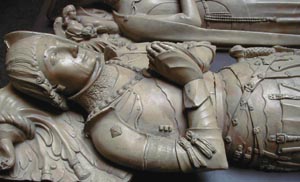
 Attachment: 54.05 KB
Attachment: 54.05 KB
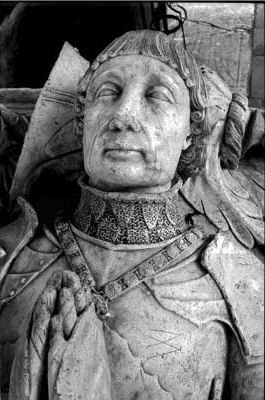
These are perhapse something that might be of interest;


Hello,
yes I know the italian style is more attached to mittens, I have a pair but I don't like it to fight with sword(for spear and halleberd it's good)...
I haven't think about the type of "hybrids" gauntlets you show, Are they some sources of this type on medieval italian tombs or every tombs were it is possibly to see an italian armour(alla tedesca or classical)??
Could you say me more informations about the pictures you show??(datation, localisation...)
Thank you for all
Fabien Laforge
yes I know the italian style is more attached to mittens, I have a pair but I don't like it to fight with sword(for spear and halleberd it's good)...
I haven't think about the type of "hybrids" gauntlets you show, Are they some sources of this type on medieval italian tombs or every tombs were it is possibly to see an italian armour(alla tedesca or classical)??
Could you say me more informations about the pictures you show??(datation, localisation...)
Thank you for all
Fabien Laforge
I belive above tomb is english ca 1470.
Thank you Schütz^^
Have you another example or a wsite where I can find myself another exemples of this typeof gauntlets?
Now a personnal question^^ what is your reconstitution group, because your avatar seems to be beautifull...
Thank you for all
Fabien
Have you another example or a wsite where I can find myself another exemples of this typeof gauntlets?
Now a personnal question^^ what is your reconstitution group, because your avatar seems to be beautifull...
Thank you for all
Fabien
These types of hybrid armours are not my main area of research, put if you obtain books dealing with the topic of italian-style armour produced in local/domestic centres you might get wiser about specific armourers, their family-names, cities of production etc.
My "signature-pic" is taken from a photo from a recent event with swedish Guild of S:t Olaus.
My "signature-pic" is taken from a photo from a recent event with swedish Guild of S:t Olaus.
The different parts of my armour are missaglia's production...
All of my actual pieces in command for a lot off (^^)are reproductions of original( helmet and gorget from royal armouries, breasplate from the Invalides at Paris, spaulders from Chicago and erm harness from archological findings in Rhodes)
Thank you for yours informations...
The Guild of St Olaus!!I like their work!!Are you member of this company??
Best regards
Fabien
All of my actual pieces in command for a lot off (^^)are reproductions of original( helmet and gorget from royal armouries, breasplate from the Invalides at Paris, spaulders from Chicago and erm harness from archological findings in Rhodes)
Thank you for yours informations...
The Guild of St Olaus!!I like their work!!Are you member of this company??
Best regards
Fabien
I seem to remember a couple of examples of gauntlets 'alla tedesca' that look very much like the classic German 'gothic' style.
It will probably take some time to track one of them down, though. One of them might be in Armature Italiane by Luciano Rebuffo, III d), from the Stibbert collection, though I can't vouch for this specific example's authenticity. I'd put up a picture if my scanner didn't have software issues.[/u]
It will probably take some time to track one of them down, though. One of them might be in Armature Italiane by Luciano Rebuffo, III d), from the Stibbert collection, though I can't vouch for this specific example's authenticity. I'd put up a picture if my scanner didn't have software issues.[/u]
Hello James.
Thank you for your post !
I'm student in medieval history but I haven't the possibility to have armors books...If you have the possibility to make a scan of the examples you talk in your post I would be exteremely grateful for you^^
Thank you in advance
Fabien
Thank you for your post !
I'm student in medieval history but I haven't the possibility to have armors books...If you have the possibility to make a scan of the examples you talk in your post I would be exteremely grateful for you^^
Thank you in advance
Fabien
Fabien, I believe there is a 3/4 fingered mitten hybrid which may be what you are looking for. Not English or Flemish, either.
I cannot find the photos I came across previously, but a rare short Milanese style mitten gauntlet did exist around those times with a finished shallow triangular finger plate covering up to the first row of knuckles on the fingers, and individual finger lames the rest of the way to the finger tips. I believe the finger lames where attached to the gloves and not directly to the gauntlet. These may have been specified by the export customers, so not a normal order per se.
Sometimes you can come across photos of Milanese export style mitten gauntlets which just seem to be too short over the fingers, seemingly made that way on purpose and not due to missing mitten lames. That leads me to believe individual finger lames where originally attached to the gloves themselves, easily lost as the leather wore out and was discarded over time...
I cannot find the photos I came across previously, but a rare short Milanese style mitten gauntlet did exist around those times with a finished shallow triangular finger plate covering up to the first row of knuckles on the fingers, and individual finger lames the rest of the way to the finger tips. I believe the finger lames where attached to the gloves and not directly to the gauntlet. These may have been specified by the export customers, so not a normal order per se.
Sometimes you can come across photos of Milanese export style mitten gauntlets which just seem to be too short over the fingers, seemingly made that way on purpose and not due to missing mitten lames. That leads me to believe individual finger lames where originally attached to the gloves themselves, easily lost as the leather wore out and was discarded over time...
Hello Torsten,
I have a type of the style of mittens you talk, but with the fingers recovered by mail and not plates...
If you have some sources...
For me I have just this photography of the casttle of churburg...
Thank you in advance
Fabien
PS: But if James have find a source for "alla tedesca" syle gauntlets, it's exactly what I reschearch.
 Attachment: 15.29 KB
Attachment: 15.29 KB
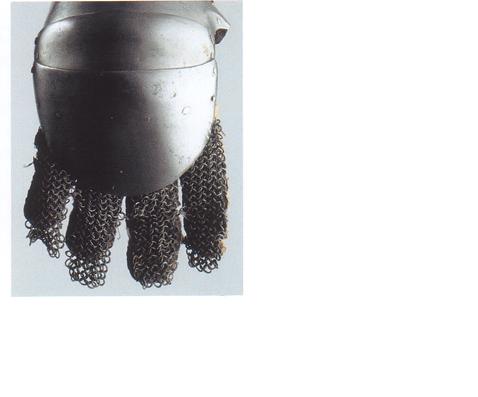
I have a type of the style of mittens you talk, but with the fingers recovered by mail and not plates...
If you have some sources...
For me I have just this photography of the casttle of churburg...
Thank you in advance
Fabien
PS: But if James have find a source for "alla tedesca" syle gauntlets, it's exactly what I reschearch.

Fabien, I would also be very interested in what James comes up with...
You find alot of these types of half-mittens in Swedens church-art, and they are even more frequent when looking at sculptures and paintings crafted locally, which is more telling then when produced in northen Germany as many was. I would say that these might be the MOST common type of gauntlets for a well armed swede late 15th cen, but then again im just going by statistics of depictions..
Attaching a few examples, there are many more;
 Attachment: 30.31 KB
Attachment: 30.31 KB
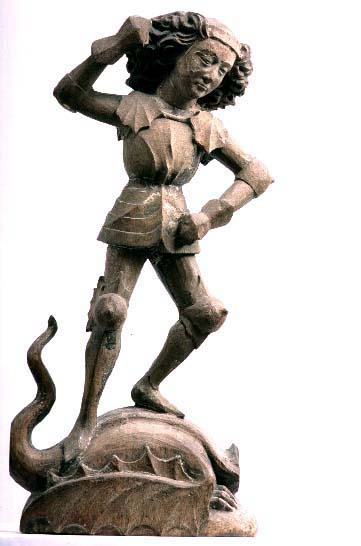
 Attachment: 59.19 KB
Attachment: 59.19 KB
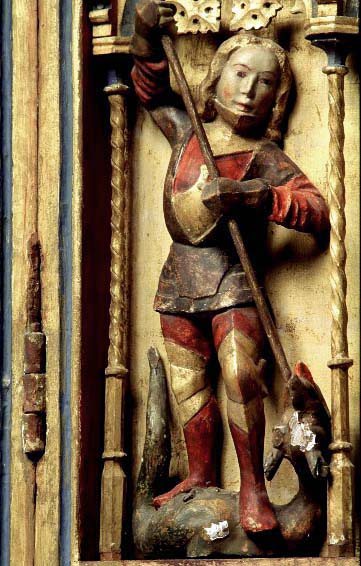
 Attachment: 44.44 KB
Attachment: 44.44 KB
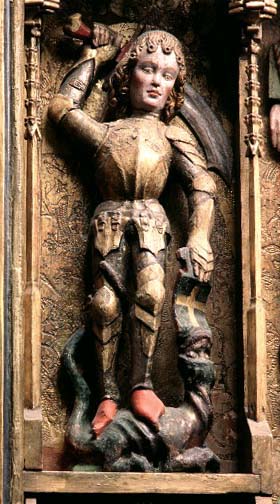
 Attachment: 35.13 KB
Attachment: 35.13 KB
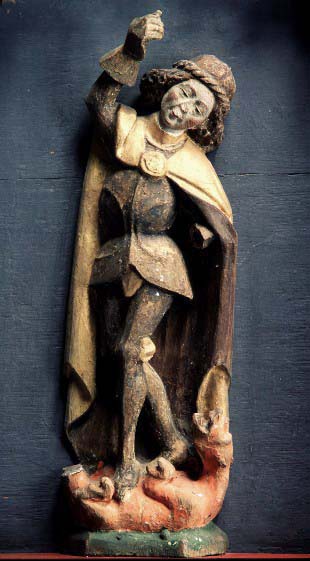
 Attachment: 40.04 KB
Attachment: 40.04 KB
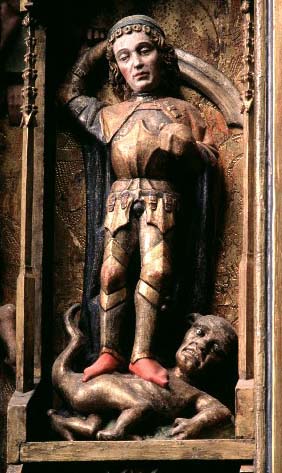
Attaching a few examples, there are many more;





Thank you for posting those great images. The second from the top is what I was trying to convey, but with a more boxy non-flared Max style cuff and lames.
Last edited by Torsten F.H. Wilke on Sun 30 Sep, 2007 10:08 am; edited 1 time in total
Most Milanese mittens, if not all, have scales or mail fingers under the plates. It has usually disappeared over time since they were mounted on leather. The rivets holes are still visible on the last plate of the mittens on all surviving examples : Montova, Glasgow, Musée de l' Armée, Grandson…
You can see the scales fingers on many period artworks, paintings (Pisanello, Ucello…), sculptures (Castle Nuovo, Naples), Tapestries (Burgundian tapestries in Bern).
I cannot remember seeing any gauntlets with fingers that would have been typically Italian in shape, not looking german/gothic. On the other hand there are a couple of mittens, of Italian conception, with flutings to fit the taste of northern clients. It could mean that export / "alla tedesca" Milanese armor where made with mittens or that Italians gauntlets looked similar to Germans gauntlets.
The main problem when fencing with mittens is not the fingers but the articulation of the wrist. I am not sure the type of mittens as in the previous post would solve your problem. In the "Livre du Roi René" on tournament there is a drawing of mittens with scales finger and an articulation at the wrist. Perhaps this type of mittens could fit your needs.
Depending on the type of fighter you are trying to portray, it is not completely unrealistic to wear German gauntlets with Italians arms. Apart from the wealthiest knight who could order a full suit of armor to Milanese or German workshop, common soldiers would use whatever they could put their hands on probably made by local workshop. Many Italian armor smith were "imported" in Touraine by Charles VII and Louis XI.
You can see the scales fingers on many period artworks, paintings (Pisanello, Ucello…), sculptures (Castle Nuovo, Naples), Tapestries (Burgundian tapestries in Bern).
I cannot remember seeing any gauntlets with fingers that would have been typically Italian in shape, not looking german/gothic. On the other hand there are a couple of mittens, of Italian conception, with flutings to fit the taste of northern clients. It could mean that export / "alla tedesca" Milanese armor where made with mittens or that Italians gauntlets looked similar to Germans gauntlets.
The main problem when fencing with mittens is not the fingers but the articulation of the wrist. I am not sure the type of mittens as in the previous post would solve your problem. In the "Livre du Roi René" on tournament there is a drawing of mittens with scales finger and an articulation at the wrist. Perhaps this type of mittens could fit your needs.
Depending on the type of fighter you are trying to portray, it is not completely unrealistic to wear German gauntlets with Italians arms. Apart from the wealthiest knight who could order a full suit of armor to Milanese or German workshop, common soldiers would use whatever they could put their hands on probably made by local workshop. Many Italian armor smith were "imported" in Touraine by Charles VII and Louis XI.
| Mathieu Harlaut wrote: |
| Most Milanese mittens, if not all, have scales or mail fingers under the plates. It has usually disappeared over time since they were mounted on leather. The rivets holes are still visible on the last plate of the mittens on all surviving examples : Montova, Glasgow, Musée de l' Armée, Grandson…
You can see the scales fingers on many period artworks, paintings (Pisanello, Ucello…), sculptures (Castle Nuovo, Naples), Tapestries (Burgundian tapestries in Bern). |
Here is a Topic thread about mitten gauntlets made by Mercenary Tailor's for me a while back that has scale fingers under the mitten plates: They may be too heavy if compared to historical ones and are sort of " overbuilt " ( heavy gage steel ) for long term durability if used for heavy and frequent reenactment battles ( something I don't do ). Allan might be able to make them lighter using thinner steel stock ?
Link to Topic and pics of the gauntlets: http://www.myArmoury.com/talk/viewtopic.php?t...=gauntlets
Here is a picture of my Milanese mittens with scales fingers.
Jean, your gauntlets seem very flexible, but they are some kind of crossover between german gauntlets and italians mittens and look more similar to XVIth century gauntlets.
 Attachment: 64.03 KB
Attachment: 64.03 KB
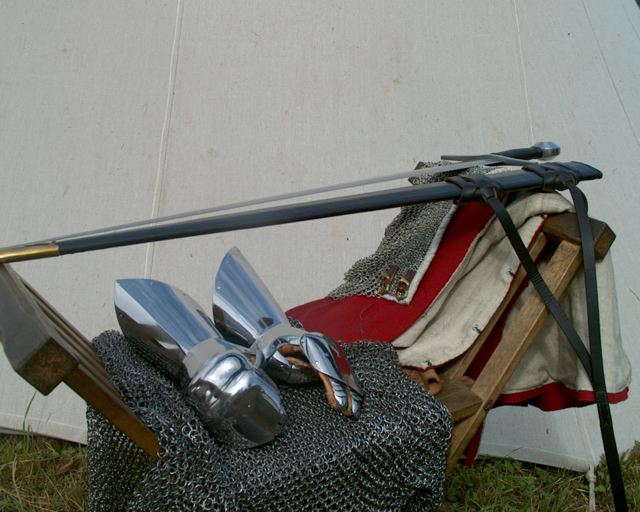
Jean, your gauntlets seem very flexible, but they are some kind of crossover between german gauntlets and italians mittens and look more similar to XVIth century gauntlets.

| Mathieu Harlaut wrote: |
| Here is a picture of my Milanese mittens with scales fingers.
Jean, your gauntlets seem very flexible, but they are some kind of crossover between german gauntlets and italians mittens and look more similar to XVIth century gauntlets. |
Yes I agree that my gauntlets may be a mix of things and are not made with the intent to conform to strict reenactment standards of historical accuracy and my personal knowledge and collecting goals are much more what I like than conforming to any specific period: More a bit of history mixed with fantasy elements or alternate history Sci.Fi. were anything can be acceptable. ;) :lol: ( Although I don't like mixing stuff that doesn't look good together I can be somewhat " forgiving " of some anachronisms: Just giving some context to my comments ).
On a practical note and back to the subject at hand: Yes they are very flexible as they do not limit my wrist movements in any way, in any direction and the only limit I feel is that with a sword I would need a very long grip to use both hands on a longsword and that a single hand sword handle would also have to be fairly long for one hand use.
The mitten plates take a little getting used to and fingering the guard is hard to do unless one slips the fingers out of the mitten strap. In this case the plates are less in the way but do flap around a bit.
In any case, the design does seem sound in principle and I thought that it might be useful to show them after the use of scale fingers used in addition to mitten plates was mentioned: Historical accuracy is an important factor depending on the objectives of the user and what would be acceptable for his reennactment activities.
Oh, and I do appreciate the comments about the possible mix of German and Italian design elements as well as the period(s) they might fit in.
Page 1 of 2
You cannot post new topics in this forumYou cannot reply to topics in this forum
You cannot edit your posts in this forum
You cannot delete your posts in this forum
You cannot vote in polls in this forum
You cannot attach files in this forum
You can download files in this forum
All contents © Copyright 2003-2006 myArmoury.com — All rights reserved
Discussion forums powered by phpBB © The phpBB Group
Switch to the Full-featured Version of the forum
Discussion forums powered by phpBB © The phpBB Group
Switch to the Full-featured Version of the forum